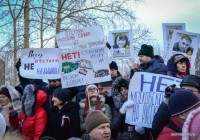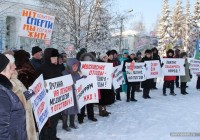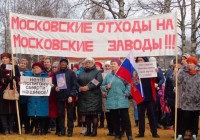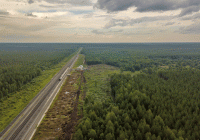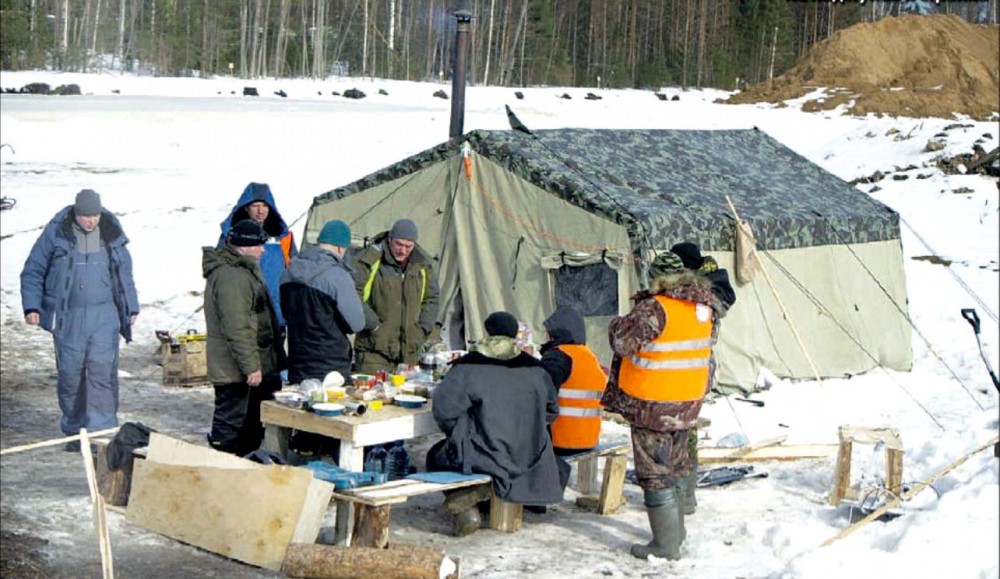
«This is our Stalingrad»
ADVERTISEMENT
By Tatyana Britskaya
Before crossing the Vychegda river, the driver asks us to unfasten our seat belts. You never know. If you are not buckled in, you might be able to jump out of the car should something happen. The ice on Vychegda is melting under the March sun. There is a 5 ton weight limit for cars and trucks. Our car only weighs two tons but even with an experienced driver, it is hard feel too comfortable crossing. There are lots of holes in the ice. Soon driving to the other side will be impossible and there will be no crossings until the ice has gone and the ferry starts working. This means that the heavy machinery will have to stop for a time. But it will also be harder for the defenders of the barricades to get help in case of provocation. Right now, it is calm on the front line. But there is a still a round-the-clock watch and protestors defending their land against the dump site being constructed to receive Moscow’s garbage are still under attack as they monitor the enemy.
Military rhetoric is the norm here. There is a sign at the entrance to the railway line that reads «Stalingrad».
«We will not back off,» explains Viktor Vishnevetsky, one of many Shies defenders. The long-closed Shies railway station is lost in the forests on the border of the Komi and the Arkhangelsk regions but today it is the hottest spot on the map of environmental protests in Russia.
Novaya Gazeta has written about the conflict in the north more than once. Since July, residents of the surrounding villages have been struggling against the construction of a huge landfill for Moscow’s garbage. The dump under construction is innocently names «Ecotechnopark» but has been organized without any public hearings, expertise or authorizing documents and despite massive public decent. However, the authorities prefer to officially close their eyes to the obvious fact. According to them, there is no construction in Shies. But in fact, the work is being done around the clock, hindered only by the people standing on the roads in the way of fuel tankers like a human shield.
ADVERTISEMENT
As of the moment, the partisan protestors’ blockade around Shies has managed to stop construction and no heavy machinery has moved since February 22. It is a stalemate and neither the besieged builders nor the inhabitants standing defiantly on the roads are willing to give in. Both sides are ready to hold on to the end and first blood has already been shed.
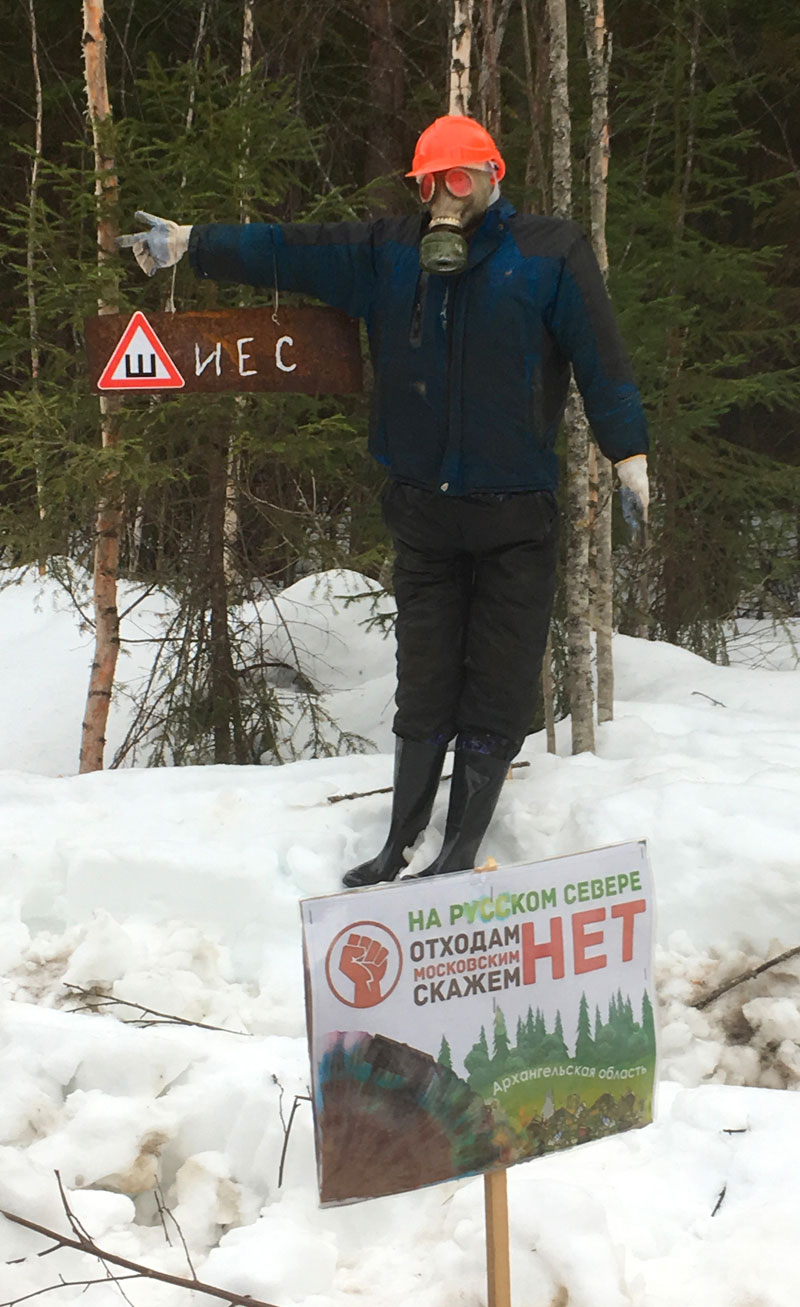
One week ago, a convoy of equipment tried to break through the protest line at the Shies construction site. After smashing the hut set up as a protest HQ, activist Vladimir Kogut got knocked down by the bucket of an excavator. One Alexey Kozlov was at the wheel of the excavator and there are several stories as to what happened next.
According to Arkhangelsk pro-government news sources, the protesters dragged Kozlov out of the cab, tied him to a tree and beat him to within an inch of his life, breaking his spine and tearing his spleen.
According to eyewitnesses, Kozlov was too drunk to drive and simply fell out of the cab and landed on his face.
The police arrived about three hours after the call and the driver was evacuated by helicopter to the hospital. Kogut was not taken anywhere by helicopter and the protesters themselves brought him to Kotlas hospital. This, as in any Russian remote place, is faster than waiting for an ambulance.
Official documents say Kozlov has lost his ability speak or walk but the next day, the heavy equipment operator refused medical treatment and went home on his own two feet. There are video recordings on the web showing Kozlov calmly walking through the hospital corridors talking with nurses. The police have nevertheless opened a criminal case against the protestors charging them with assault and causing him injuries of moderate severity. Activist checkpoints have already been visited by the police.
Kogut also refused treatment but the police do not recognize him as a victim.
But the people of the region do consider themselves victims in this and are tired of being seen as no more than a garbage dump by Moscow.
Ruslan, a resident of Madmas, is indignant. «We have pregnant women here but there have been no medical helicopters for ten years. There is never any money. And they knew about this at the beginning.» Ruslan lives in a small log house, has a strong family and a good job. His son Ivan is participating in the protests along with his father. «The state has never given us a second thought. And now, they only think of us as a dumpster.»
Elena Mayle is an entrepreneur. She comes from Arkhangelsk and lives in Komi with her husband Denis. Previously, neither had gone to rallies or tried resist the decisions of the authorities. For them, as well as for the majority of the «Shies guerrillas», this is their first experience fighting back. «We first - as soon as we learned about the construction site - we conscientiously wrote complaints to all instances and waited to see how the authorities would react. When we realized that they were not going to do anything, we decided to take matters into our own hands.» Elena and her husband consider themselves citizens of the region and she jokes that God himself has told them to protect Shies, «If the worst predictions come true, ecological disaster will cover both regions.»
Businessman Viktor Vishnevetsky from Syktyvkar offers this, «Shies is a wakeup call for our community. Even pension reform did not affect people this way. This is a spark, like the shooting in Sarajevo. And this garbage deal has revealed a chain of problems including corruption, social disorder…»
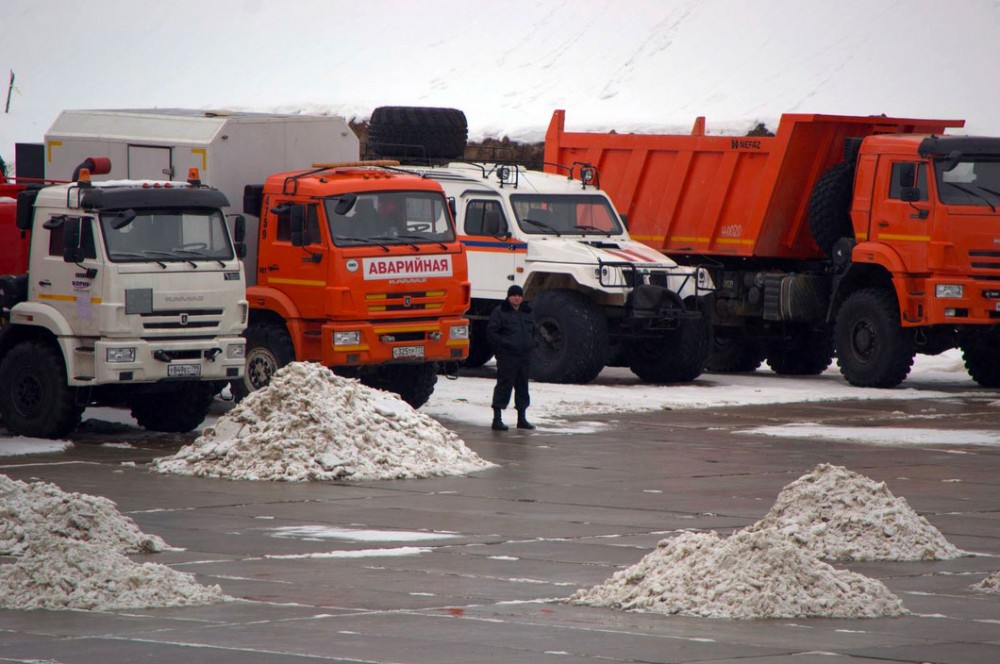
Communist Oleg Mikhailov adds, «The Komi Republic pays 151 billion (about €2 billion) in taxes a year to the federal budget, and yet only 55 remain in the regional budget. And the net profit of Lukoil Komi, our main oil producing company, is 420 billion a year. Moscow takes everything from us. They take our money, our resources and our minerals but they are only ready to give us their garbage in return.»
The Shies protest partly resembles the story of the Sun protest to fight off logging companies from destroying the Boron forests in Karelia. There, pensioners also served as partisans, standing their ground despite minus thirty-degree frosts along with activists, businessmen, teachers, journalists, firefighters, village deputies and even employees of Gazprom. The latter were working on the maintenance of a branch of a gas pipeline passing through the entire region. They don’t have any gas service, by the way, in the villages.
Before going to the front line, we have to put on yellow vests. The yellow vests have nothing to do with any brotherhood with the Parisian protests, they are simply complying with the law. It is illegal to work on or along railroad tracks without a yellow vest. And it is dangerous with the speedy Moscow-Vorkuta express and the rattling the freight trains running almost every quarter of an hour. The Shies station itself has been closed for quite some time and only a few trains make 2 minute stops there. There used to be a logging village here but it closed down before the time of perestroika and the last families left in the 90s.
Now the only logging that gets done here is done by private traders and not always legally. The wild forests have retaken the territory and the nearest village is Madmas, 4 km from the railway. In the 80s, 3,000 people lived here but now there are only 700 left, mostly exiled ethnic Germans. In the 90s, most returned to Germany and only a stoic few have stayed on.
«This is my homeland, where should I go?» says Alexander Neiman, who refused to repatriate despite the requests of his 90-year-old grandmother who died in Germany without seeing her grandson. «My mother also refused to move. She said that this was her home and I will stay here too. My father is buried here and my brothers. This is my land and I will not give it up. My grandfather did not come here all the way from Berlin for me to just give up my land. And if we let these people spit on us, they will continue to spit on us.»
Neumann works in the fire department. When not on shift, he has been manning one of the roadblocks that the protesters have set up around the construction site. There are no reprisals for his participation, on the contrary, according to Alexander, when they tried to recruit locals to help with the dump site construction, the bosses there were clear that anyone who tried to work there should not plan on coming home again.
And it is no easy decision for a local to refuse to work at a construction site. Men can earn up to 60 thousand (€820) a month, and women might find 40 or 45. It’s impossible to imagine such wages in the villages. But people refuse.
«We still drink the water from our wells and we collect berries and mushrooms. If we let them build this Chernobyl here, what will happen to our children?» asks Neyman.
***
The blockades started in the village of Madmas. Two roads intersect there and fuel and building materials can be brought to the construction site only along this road. At first they wanted to put up a roadblock right in Madmas but they had to do it in the forest. The residents were angry and didn’t want any more problems on its fragile dirt and gravel road. They were not very good roads to start with but in just a few months during the summer, trucks belonging to Yuri Vasilyev, an entrepreneur from Syktyvkar working for the dumpsite, destroyed them. And though Vasiliev has promised to repair the road, nobody expects any promises to be kept.
Desperate to get help from the cops, the protesters demanded that the KamAZ trucks adhere to the rules of the road. They are technically not even allowed on the road which is not rated for heavy trucks. When the authorities turned a blind eye, the people started blocking the road by any means possible, including laying “hedgehogs”, spiked metal bands, across the road to destroy the tires of the great trucks.
The flow of sand stopped on its own but the checkpoint is still there. Trucks have tried to break through a line of protesters using their bodies to block the road a couple of times. The human shield managed to stop one column of fuel trucks and then another. Then an «authoritative person» from Syktyvkar was sent. He already had one conviction in his pocket and he let the activists know that it was time to curb their protests. But the people stood their ground. And then one night some thugs showed up, tough guys with their faces hidden under balaclava. But the activists are on line and connected and in a few minutes, 70 people drove up to see what all the fuss was about. The thugs scurried back into their holes.
Basic communications here at the front is via the Internet. The Defenders of Shies social network has 18 thousand people. And they are helping finance the war. Some send 100 rubles, some send 300 and some provide food or a thermos of hot tea. It all helps.
«They are saying that in the future, this will be known as the «Chernobyl» landfill. We don’t want Chernobyl here,» Yury Shigarev categorically states. Shigarev is a pensioner and is on duty all day. Pensioners are not afraid of builders or gangster thugs. And then he adds gloomily, «There is a gun in every house. We are all hunters here. Spring will come and we will be in the forest. These builders will not want to stick around.»
The project, as presented by Technopark LLC, who are the main contractors, calls for a bit more than 20 years of operation. The plan is to import 10 million tons of crushed, compressed and plastic-packed garbage from Moscow and burry it here in the Shies landfill. The waste material will be compressed in Lyubertsy and then exported north. It is clear that we cannot talk about any alternative use of waste in this form. We are talking about garbage that will simply not decompose or be suitable for any further processing.
When people found out about the project they began to rebel. At first, the authorities promised that they were not building a landfill, they were just putting together a modern waste collection system as well as new a woodworking enterprise. But this story did not last and the truth came out. The plan allocates 300 hectares of land for burial of Moscow’s garbage. According to the documents, this is supposed to be forest land. But the management of «Technopark» has already cut down 30 hectares for technical buildings for unloading the trains near the Shies station. They will be burying the garbage where a thick fir grove is now standing. The documents transferring ownership of this land have never been officially approved.
The main position of the protestors is that this is an environmental catastrophe waiting to happen. The local terrain is marshy, there are swamps and peatlands all around and the depth of groundwater is only 40 cm. Should there be any spontaneous combustion from the garbage, there will be nothing to stop the fire. Or worse, if the tightness of the packaging of the garbage briquettes is broken and the putrid waste falls into the water, we are talking about polluting ground water that feeds the sources of 8 northern rivers. And if the swamps are drained, the surrounding moisture-loving spruce forests will simply die.
«Some specialist from the «Serebrenaya Taiga» Foundation told us that by 2020, they would have a forest reserve organized at this place. But instead of the reserve, there will be a cesspool, albeit a relatively modern one,» activist Sergei commented.
«People are standing up for their lives, for their natural environment. These natural forests give them everything. They live for the whole year on what they can collect during the summer. This is their way of life. And now everything is being taken away from them,» Victor Vishnevetsky explains. «Our forests are being cut down, our water and air are polluted with emissions, now our swamps are being destroyed. I do not need any documents to understand that these are swamps or that nothing should be built here. I am here!»
Victor is one of the unofficial protest partisans. His wife is a beautiful, well-groomed business woman and he has a toy store in Syktyvkar and his activities on the social networks have already harmed him. A year ago, Vishnevetsky received a 6 month suspended sentence under article 282 for reposting anti-government material on the net. But nevertheless, he has spent the last months on duty here in the Shies swamps. He has brought journalists here and is helping to keep this thing alive. He says he could have sold everything and left a long time ago. But why should he?
There is a house built on wooden posts and generously decorated with flags that stands near the railroad tracks. Ivan Ivanov, an activist from the Save Pechora Committee, one of the country’s oldest environmental organizations, conducts Internet broadcasts from here. It was created by the simple residents of Komi villages in the 80s to protect the earth from oil spills. Now the Committee is involved in the Shies protests.
The Vychegda Rescue Committee, an organization modeled after the Save Pechora Committee, is here too. Ivanov goes to the construction site every day. He demands documents from guards and asks questions. In response, he gets only irritation and abuse. Today, I am invited to go with him. We are heading into ground zero.
As soon as we appear on the site, we are suddenly the center of attention for 30 large men in red berets and black uniforms who snap onto us like iron to a magnet. They are all wearing video recorders on their chests and have rubber batons on their belts. The only insignia they carry are chevrons with the inscription of the Moscow private security company «Security Guarantor».
The men need to see our documents but they will not present theirs. Finally, one of them shows his card as a private security guard. Two policemen appear. They also ask for our documents. We ask the police what the men in black are doing here but one of the district policeman only smiles and replies that they are «enjoying a pleasant walk».
Ivan comments on the illegality of the construction on their forest lands but this does not arouse anyone’s interest.
«I don’t know if there are any documents that say this is a protected or private forest and there are no documents saying that it’s impossible to build here.» says the captain, «All we are doing is guarding the railway station. Apparently, it has become a very dangerous place.»
The site is paved with concrete slabs and there are KamAZ trucks with Moscow and Arkhangelsk numbers parked here. There is a hostel nearby for workers but it’s impossible to talk to them. The guards lead the workers past us with choreographed precision and three guards block off the road to the hostel. There is a piece of paper on the door that says that the area is under protection inside and out and that the territory is under constant video surveillance.
Any questions directed towards the private security people, or «сhopiki» as they are called by activists, are answered only with a smirk and a practiced «we just came out here for a little walk». And then they start getting aggressive, pushing us back, pressing us together, obviously trying to provoke a scandal.
«You are just here for the money,» one of the guards offers, «otherwise, where did you get the Internet and satellite dish? These people are just provocateurs. They just get drunk and lie around every day…». Not one of these guys with cameras strapped to their chests shows us any photos or videos giving evidence to such claims but they have no problem pressing us more tightly trying to get us to start a fight.
We continue to inspect the area. There is a hangar sized building where, according to the activists, they are storing the imported diesel to run the generators. To speed things up, they pour it straight from a railway tanker, which is also against any rules.
One of the guards suddenly explodes, «Hey, I also need to feed my children. Why are you reproaching me?» Ivan nods and quietly tells me that most likely, the «enemy» is preparing for decisive action. There were different guards with different badges a week ago. The old ones were more peaceful.
Finally, we reach the fence, enclosing the construction from the Urdom side. We are technically in the Arkhangelsk region. Formally, the whole Shies station is within these boundaries and Komi officials justify their inaction with exactly this nuance. They say that their hands are tied and that they have no power to do anything no matter what happens. And yet, it is only 18 km from Madmas to the future landfill.
There is an sign hung on the forest side of the fence that says «No death dump!» On the Komi side, another sign reads «Putin, stop building!»
Behind the fence, we can see the scars of battle. What is left of the former command house that was crushed by Kozlov’s excavator is burned. The activists say that the hot stove inside was damaged during the «battle», the coals continued to smolder and flashed the next morning.
The other side of course claims that the activists showered the excavator with Molotov cocktails. In the hospital, there was no evidence of any burns as Kozlov was chatting up the nurses on the way home from the hospital and the excavator itself is standing there unharmed. The next convoy, accompanied by both Komi and Arkhangelsk police, did manage to break through from the construction site to Urdom.
People say that one of the technical vehicles was driven by a businessman named Vasilyev, who leased the car himself. Working for Technoparek simply means greater losses for him. But why would the police of both regions choose to serve as an escort for empty private cars? Activists say that drivers had been asked for their documents while they were taking on fuel for the construction site but no one had any.
Another local businessman who contracted to work at the construction site was a certain Sidorov, who has become an object of sincere dislike for villagers. Sidorov, according to them, owns the ferry and charges 250–350 rubles for transporting a Vychegda 50-meters across the river, as astronomical price by local standards.
Sidorov was contracted to cut wood in the Shies forest. But instead of picking up some quick money, he got himself arrested. Some people from Urdom, the village closest to the construction site, filed the case against him because cutting trees is illegal without a license. Sidorov was detained, although they did not send him to the detention center. Local journalists believe that if the government somehow changes their minds, Sidorov might be locked up for quite some time.
And finally, a fire is burning 20 meters from the construction site where the men in black are «enjoying their little walk». A tent city of protesters has sprung up here and it is the first line of defense. Vladimir offers us some tea. He is over 60 now and says that he has always been loyal to the authorities and has never gotten involved with politics. But now he is working 3 days on and three days off here. He sleeps for two hours and stays on duty for two hours. And he has no intention of retreating.
«Have you seen the Stalingrad sign? That was no accident. We will never give up our land. We have nowhere to retreat. I have grandchildren here. If we allow this Moscow garbage here, they will have no life. And I’m a pensioner. I have nothing to lose. So I will stand here until the end. None shall pass.»
Translated from Russian by Adam Goodman
This story is originally posted by Novaya Gazeta and translated and re-published as part of Eyes on Barents, a collaborative partnership between news organizations and bloggers in the Barents region


